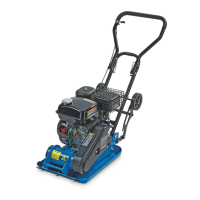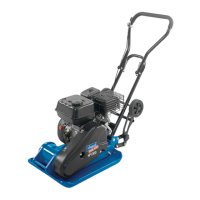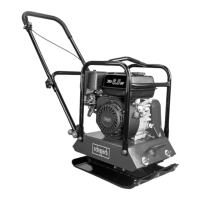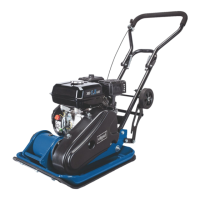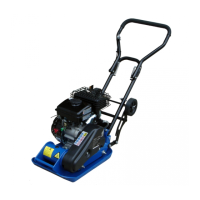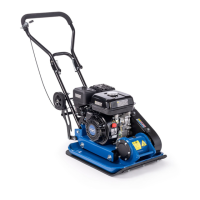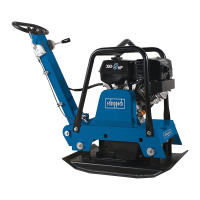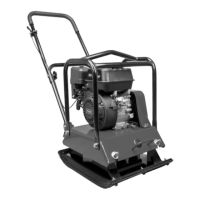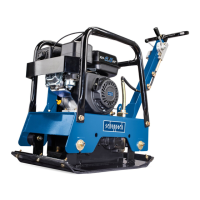7
General notes
• After unpacking, check all parts for any transport dam-
age. Inform the transport agent immediately of any
faults. Later complaints cannot be considered.
• Make sure the delivery is complete.
• Before putting into operation, familiarize yourself with
the machine by carefully reading these instructions.
• Use only original accessories, wearing or replacement
parts. You can find replacement parts at your schep-
pach dealer.
• When ordering, include our order numbers and the type
and year of construction of the machine.
HP800 HP1100 HP1300
Extent of delivery
Vibratory plate with motor
Vibratory plate
Handle
Wheel base
Rubber mat
1 fixing bar
Small parts
Operating instructions
Technical data
Max. motor power kW: 2.09 4.0 4.8
Piston capacity ccm: 87 163 196
Motor type: 1 cylinder/4-stroke
Fuel: gasoline 90 octane
Tank volume: 1.1 l 3.8 l
oil charge/quality
0.35 l 0.6 l/SAE 10W-30
Running speed m/min: 25 15
Vibration strokes: 5900 vpm 5500 vpm
Working plate L x W mm: 495 x 320 530 x 350 540 x 420
Compaction pressure kg: 820 1100 1300
Weight kg: 49.0 58.0 82.5
Subject to technical changes!
Noise parameters acc. to EN ISO 3744
HP800 HP1100
HP1300
Sound pressure level Lp(A) 80.6 db(A) 81.5 db(A) 82 db(A)
Sound power level Lw(A) 101 db(A) 101.5 db(A) 102 db(A)
uncertainty K 2.63 db(A) 2.40 db(A) 2.28 db(A)
vibration a
h
17.5 m /s
2
10.8 m/s
2
15.6 m/s
2
uncertainty K 1.5 m/s
2
1.5 m/s
2
1.5 m/s
2
The values stated are emission values and are therefore
not necessarily safe operating values. Although there is
a correlation between emission and immission levels,
you cannot reliably deduce from this whether additional
safety measures are required or not. Factors which can
influence the immission level currently at the work sta-
tion comprise the duration of the effects, the character-
istics of the work room, other sources of noise etc., for
example, the number of machines and adjacent opera-
tions. The permissible values per work station can also
vary from country to country. This information should nev-
ertheless enable the user to make a better estimation of
dangers and risks.
Uwagi ogólne
• Niezwłocznie po rozpakowaniu maszyny należy spraw-
dzić wszystkie części czy nie uległy uszkodzeniu pod-
czas transportu. Wszelkie stwierdzone nieprawidłowości
należy natychmaist zgłosić do przewoźnika. Późniejsze
reklamacje nie będą honorowane.
• Upewnij się, że przesyłka jest kompletna.
• Przed uruchomienim maszyny zapoznaj się z nią poprzez
uważne przestudiowanie niniejszej instrukcji.
• Używaj tylko oryginalnych akcesoriów, części zużywal-
nych i zamiennych. Wszystkie części dostępne są u
przedstawiciela rmy scheppach.
• Składając zamówienie należy podać numer katalogowy,
typ i rok produkcji maszyny.
HP800 HP1100 HP1300
Zakres dostawy
Zagęszczarki z silnikiem
Płyta wibracyjna
Uchwyt
Podwozie
Mata gumowa
1 pręty mocujące
Części drobne
Instrukcja obsługi
Dane techniczne
Max. moc silnika kW:
2,09 4,0 4,8
Pojemność cyl. ccm:
87 163 196
Typ silnika: 1 cylinder/4-swowy
Paliwo: Benzyna 90-oktanowa
Pojemność zbiornika:
1,1 l 3,8 l
wsad oleju/quality
0,35 l 0,6 l/SAE 10W-30
Prędkość rob.:
25 15
Uderzenie wibracyjne:
5900 vpm 5500 vpm
Płyta robocza DłxSz mm:
495 x 320 530 x 350 540 x 420
Ciśnienie ładowania kg:
820 1100 1300
Ciężar kg:
49,0 58,0 82,5
Zmiany techniczne zastrzeżone!
Wartości hałasu zgodnie z norm EN ISO 3744
HP800 HP1100
HP1300
Poziom ciśnienia
akustycznego Lp(A)
80,6 db(A) 81,5 db(A) 82 db(A)
Poziom mocy akustycznej
Lw(A)
101 db(A) 101,5 db(A) 102 db(A)
niepewnośćK
2,63 db(A) 2,40 db(A) 2,28 db(A)
poziom drgań a
h
17,5 m /s
2
10,8 m/s
2
15,6 m/s
2
niepewność K
1,5 m/s
2
1,5 m/s
2
1,5 m/s
2
Podane wartości są wartościami emisyjnymi, przez co nie-
koniecznie winny być uznawane za bezpieczne wartości
operacyjne. Jakkolwiek istnieje pewna korelacja pomiędzy
poziomami emisji i imisji, nie można z tego w wiarygodny
sposób wywnioskować czy wymagane są dodatkowe środki
bezpieczeństwa. Czynniki składające się na poziom imisji
w danym momencie na stanowisku pracy to okres trwania
efektów, właściwości pomieszczenia roboczego, inne źródła
hałasu itp, na przykład liczba maszyn i działań w bliskim oto-
czeniu. Wartości dopuszczalne na jedno stanowisko pracy
mogą się różnić również w zależności od kraju użytkowania.
Informacja ta powinna jednak umożliwić użytkownikowi do-
konanie lepszej oceny zagrożeń i ryzyka.

